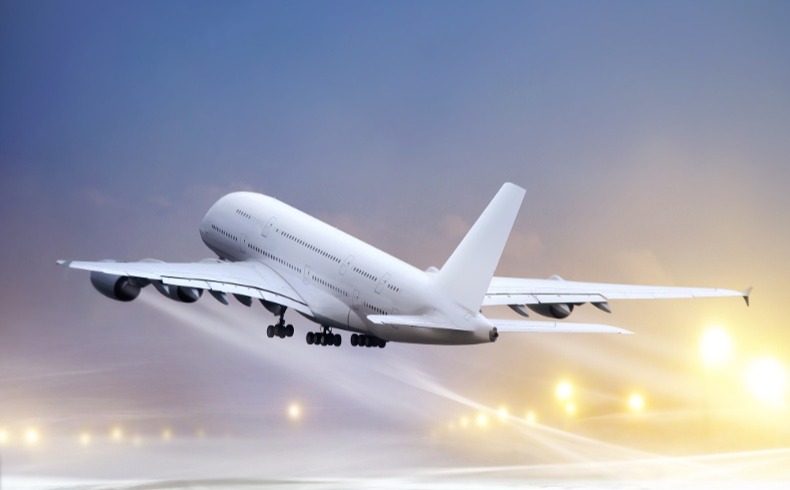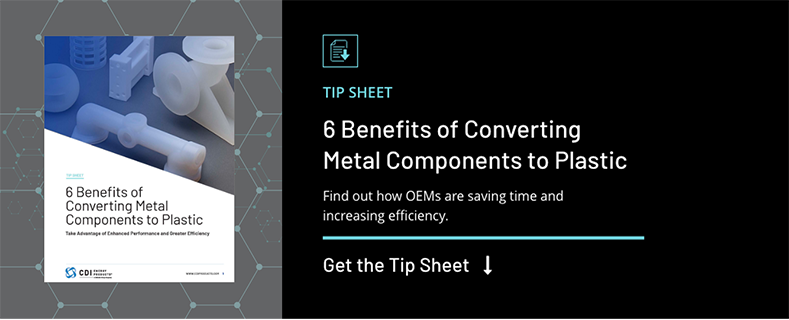
Thermoplastics and the Modern Aviation Industry
Posted by CDI Products on Sep 22, 2021
Hugo Junkers, a German aircraft designer, created the world’s first all-metal aircraft in 1915. The fuselage of the Junkers J 1 monoplane was constructed entirely of an aluminum alloy containing copper, magnesium, and manganese.
In 1967, a new aircraft made of 80% aluminum was introduced to the world – the Boeing 737. By 2013, Boeing and Airbus were propelling the aviation industry in a new direction, with new aircraft composed of 50% composite and polymer materials instead of aluminum, titanium, or steel.
What explains this dramatic shift from traditional metals in favor of thermoplastics like PEEK, PPSU, PEI, and other high-performance polymer materials?
Moving Away From Metals
Did you know that thermoplastics and composites can be up to 10 times lighter than metals? Using composites and thermoplastics directly impacts the weight of the aircraft and significantly cuts lifetime fuel costs, lowers emissions, and increases flight range.
Aerospace-grade polymers and thermoplastics such as polyetheretherketone (PEEK), polyphenylsulfone (PPSU), polyetherimide (PEI), and polyether ketone ketone (PEKK) all contribute to weight reduction in a dependable and cost-effective manner. Beyond weight reduction, they also deliver strong value in a variety of applications due to their unique features that outperform metallic components in terms of corrosion and fatigue resistance, insulative properties, and durability.
High Standards in the High Skies
Aircraft are subject to extreme fluctuations in altitude, pressure, temperature, and speed, coupled with dynamic weather and environmental conditions. To mitigate risk, aircraft are designed to withstand an incredible amount of stress and strain, and aircraft manufacturers incorporate a substantial safety margin into their designs.
When lives are on the line and environmental conditions cannot be controlled, every piece of equipment and every component on an aircraft must be carefully considered. In essence, each element is mission-critical and choosing the optimum materials can prevent failure. With such high risks, material selection plays a critical role in air travel.
To learn more about high standards in aerospace, check out our blog on CDI’s recent AS9100 certification. AS9100 is an international collaborative effort to create a fully robust and standardized quality management system specific to the aerospace industry.
In our blog on thermoplastics versus thermosets we talked about the benefits of thermoplastics. The inherent properties thermoplastics and their composites provide are ideal for aviation and aerospace applications. Not only do thermoplastic composites offer a great strength-to-weight ratio, but advanced polymer composites can also withstand the extreme temperatures found at high altitudes and provide the temperature stability necessary to combat solar load.
Thermoplastics offer a noncorrosive base with low water absorption, allowing for natural buoyancy. Thermoplastics are also inherently flame resistant, which helps aircraft manufacturers to meet the stringent standards for flame, smoke, and toxicity (known as FST standards).
Composites and thermoplastics also help reduce production and operational expenses, as they are generally more cost effective to make than glass and metal, coupled with a rapid production rate. By replacing all mechanical and interior metal components with plastic alternatives, operators can save up to 50% on overall costs.
Bottom line: Composites and thermoplastics provide aerospace companies a more cost-effective option for aircraft that boosts efficiency without sacrificing durability or safety.
Preferences for Polymers
PEEK is one of the most trusted and most used metal substitutes in the aviation industry. PEEK’s chemical properties include ideal conditions for weight, creep and fatigue resistance, mechanical strength, and efficiency and cost for manufacture. PEEK can be used in a variety of applications, including flight control, fuel systems, aircraft interiors, aerodynamic components, and much more.
Ryton® [Polyphenylene sulfide (PPS)] is also readily used for aerospace applications to manufacture injection-molded parts with tight tolerances. Ryton’s® inherent characteristics deliver dimensional stability, fire retardancy, thermal stability, and corrosion resistance.
Radel® [Polyphenylene Sulfone (PPSU)] exhibits exceptional toughness and outstanding hydrolysis resistance and provides superior performance without loss of dimensional stability or physical properties. The material additionally provides resistance to common acids and bases. Radel® is also resistant to high temperature environments with a heat deflection temperature 405°F.
Ultem® [Polyetherimide (PEI)] is a semi-transparent thermoplastic that has excellent heat, solvent, and flame resistance. This thermoplastic performs in continuous use applications up to 340°F (170°C). While Ultem® is moldable by traditional processes, it is also easily machined and fabricated with excellent strength and rigidity. In addition to its high temperature performance, the material also exhibits a high dielectric strength, inherent flame resistance, and extremely low smoke generation.
Torlon® [Polyamide-imide (PAI)] is regarded in the material science industry as the highest-performing melt-processable thermoplastic. Due to its outstanding mechanical strength, impact resistance, and ability to tolerate temperatures of up to 500°F (260°C), Torlon is often used to replace metals in a number of applications, including aircraft wings, doors, seating, fueling systems, propulsion system components, and even spacecraft exterior paneling.
A number of other thermoplastics are used in the aerospace industry, with new advancements in polymer science opening new opportunities every day.
Global Economy Means an Increase in Air Travel
Since the early 1960s, growing demand for passenger and freight services, technological advancements, and increased investment have propelled the aviation industry while helping to connect people, communities, and cultures around the globe.
As our world becomes increasingly more connected, aviation becomes more essential to supporting our global economy. Air transport does more than transport passengers. Aircraft are increasingly used for essential goods and food supply transport, military operations, humanitarian aid, and disaster relief.
Where Will Thermoplastics Take Us Next?
The promise of urban air mobility, global delivery drones, personal propulsion devices, and supersonic travel seem closer to reality than ever. Industry pioneers are looking at innovative ways to transform the air travel experience and to raise the bar on transport efficiency.
Nontraditional players and startups are entering the market and changing the competitive dynamics. With an emphasis on improvement, there is plenty of room for research and development when it comes to thermoplastic applications for aviation and aerospace. A recent article discussed thermoplastics and composite aerostructures and how they might lay the groundwork for piloted and autonomous air taxis. (Yes, that’s right. Flying cars!)
Advanced materials and thermoplastics can open the door to new functionality like self-healing structures, energy harvesting, and even camouflage. With chemists and material scientists around the world researching ways to make thermoplastics and composites better, stronger, and more sustainable, the opportunities to revolutionize air travel abound.
Topic: aerospace, engineered thermoplastics, thermoplastics, AS9100 certification

